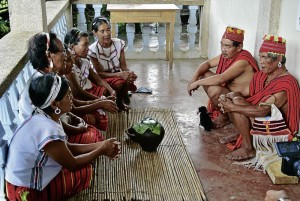
Good news travels slowly.
Filipinos like thinking that conservation in this country is in a sorry state, but 2012 was the year Philippine conservation efforts received global accolades.
It was one success story after the other for the Philippines in 2012, successes that firmly established our reputation as an international leader in conservation.
In July, the World Heritage Committee removed the Rice Terraces of the Philippine Cordillera from the World Heritage “In Danger” list.
The Rice Terraces of the Philippine Cordillera were inscribed on the World Heritage List in 1995 for being “a dramatic testimony to a… communal system of rice production… an outstanding example of land use resulting from a harmonious interaction between people and their environment that has produced a steep terraced landscape of great aesthetic beauty…”
After the national government drastically cut down support for the terraces, leaving the managing authority practically without a budget, the site suffered severe degradation and was placed on the “In Danger” list of World Heritage properties in 2001.
The “In Danger” designation to a World Heritage-inscribed property means the property is in need of intensive care, and the host country should carry out careful rehabilitation.
In some instances, international organizations assist in the rehabilitation. In the Philippines, most of the funding was locally generated.
The “In Danger” listing was a blessing in disguise. So was the cutting down of national support. It motivated the Ifugao community to take charge.
Getting off the “In Danger” list was no mean feat. It took 12 years of hard work on a shoestring budget until the “In Danger” was delisted.
However, at the World Heritage Committee Meeting of 2012 held in St. Petersburg in the Russian Federation, committee members applauded the Ifugao people as a rare and outstanding global example of community-led conservation.
Vigan front-lines
In November, the Heritage for City of Vigan was awarded by Unesco as “Best Practice in World Heritage Site Management.”
Chosen over 28 other cities in 23 countries competing for the award, Vigan was declared winner because of its “good management practice in spite of limited resources, making [its example] adaptable in other countries.”
Judges lauded the high level of community participation in Vigan starting in the mid-1980s when the local population held frequent consultation meetings to debate whether the city should prepare for World Heritage nomination.
Upon its inscription in the World Heritage List in 1999, the Vigan City government immediately organized local community members as front-liners in conservation of their heritage, making them aware that heritage, if properly conserved, was a resource for community development.
Vigan believes that development is feasible if heritage is considered in every step of the improvement of the local quality of life; therefore, the community was invited to participate in the planning and implementation of city programs and projects and also in preserving their heritage.
Vigan is a global example that sustainable development can happen hand in hand with protection of entire districts of old buildings, which give the city its character.
Case studies
Also happening last November, the Philippines hosted the International Council for Monuments and Sites (Icomos) Conference on Cultural Tourism for Community Development.
Close to 40 cultural-tourism experts from foreign countries went to Vigan to present case studies on various success stories on how heritage tourism had benefited the local residents.
An audience of 375 attended, composed of Icomos Philippines members, tourism practitioners, and students from different universities in the country.
Well-received was the presentation of Kularts Tribal Tours and Cultureright Travel, which organizes culturally and environmentally sensitive tours in the T’boli areas of Mindanao, an outstanding example of community development through tourism.
The issue of presenting heritage in a more interesting manner was shown in an innovative museum guide training program implemented by Greenwich (London) Maritime Museum.
Other foreign participants presented their work in museum planning, interpretation, preservation of historic districts, and tourism education.
Unanimous were the foreign participants in saying Vigan was an excellent example of how heritage had benefited a community.
As a result of the Philippine presentations at the Vigan Conference, Icomos Philippines was invited to conduct cultural-tourism training workshops next year in two countries, Sri Lanka and Timor Leste.
It’s been a good year for heritage and for the Philippines. But we should remember, there is still much to do.
Comments and feedback are appreciated: pride.place@gmail.com